Employee Ownership Myth 1: Employee Ownership Is Good For Founders…But Not So Good For Most Employees
2 Comments Published by Dr. Beyster June 1st, 2007 in Employee Ownership.This is a busy week for guest bloggers. Here is the first in a series of articles that we’ll run this summer by our third guest blogger Bill Scott on the topic of employee ownership myths. Most of you probably know that Bill was a physicist with SAIC from its earliest days, and he served as chairman of the Technical Environment Committee for a decade. Do you agree with Bill’s article? Do you disagree? Please comment on the blog so I can see what you think about it. – Bob
* * *
I’m Bill Scott, physicist at SAIC from 1970 to 2006 and Chair of the Technical Environment Committee from 1982 to 1992. My specialty has been the calculation of nuclear radiation environments including its shielding, detection, and simulation. I’ve found that the math of radiation and of economics to be similar, so that I’ve made a hobby of studying the financing of employee ownership. I’ve written a series of articles comparing some of the important big ideas of employee ownership to mathematical correlations with SAIC’s history. As Bob’s book lays out, the ideas of EO are important the success of SAIC. Backing this up with financial studies can help focus the discussions. I hope you will find these math myth papers interesting, and I will be pleased to discuss any questions or comments with you through this blog.
Myth #1: Employee Ownership Is Good For Founders…But Not So Good For Most Employees
By Bill Scott
Employee ownership can be very good for a company’s founders and longest-term employees. Why? Because they often end up owning a substantial amount of the company’s stock. However, newer employees can also accumulate significant wealth. At Science Applications International Corporation (SAIC) — the largest employee-owned science and engineering firm in the United States — the ownership principle was that those who contributed to the company’s success should become owners, and that ownership should be commensurate with each employee’s contribution. Employees who have contributed longer will naturally own more of the company than those who have contributed over a shorter period of time.
The question for new employees is whether the stock flows they might receive will be sufficient in future years for them to build up substantial equity over time. Figure 1 presents a simple exercise in compounding and exponential growth. Notice that after 20 years, the stock balances have become significant. The assumptions are that the stock price grows 12 percent for 20 years, and that the company’s stock programs continuously provide 5 percent, 10 percent, or 20 percent of an employee’s annual salary worth of stock each year. The 5 percent curve is meant to represent an employee who is not aggressively acquiring stock but is obtaining some shares through an ESOP, 401(k), bonuses, payroll deductions, or direct purchases. The equity is worth four years of salary after 20 years and is creating the foundation of a reasonable retirement. The 20 percent curve represents an employee who is both purchasing stock and being awarded healthy bonuses. This results in substantial wealth (16 years of salary) after 20 years. The middle 10 percent curve represents an employee who receives either modest bonuses or makes active purchases.
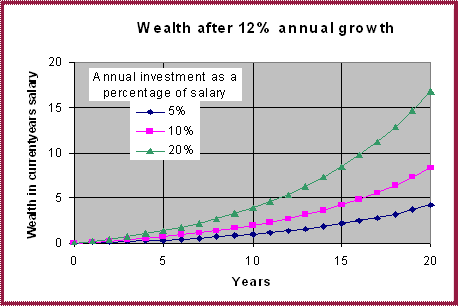
Figure 1
It is important to note that employees acting for themselves through payroll withholding and direct purchases can gain the same amounts of equity as employees receiving performance bonuses, and that longevity is very important. An employee who acquires stock half as quickly as a colleague can overcome this deficit by just five years of additional longevity.
Click here (PDF file) to read the rest of this article.

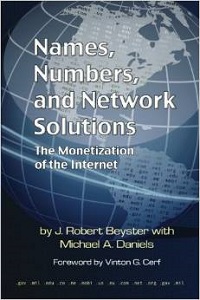
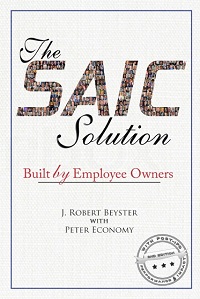
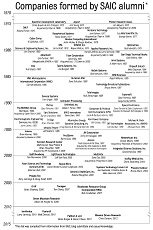
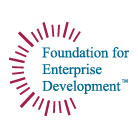
I do not disagree. My father, a product of a depression era family, always impressed upon me the power of compounding during my youth. He was not able to experience the effects of exponential growth in his lifetime however.
I do recall one story around Bill Scott (My recollect is faint however and I can’t recall the article, as the online Wall St. Journal archives only go back to 1996) regarding he being interview by the WSJ to explain the SAIC stock pricing formula, which, if I remember, was published in the paper on one of the inside front pages as a graphic.
I think I recall humor around the “math” involved in that formula being too advanced for most of the Journal readers. Do you have a hardcopy of that article?
Bill, Good to hear from you, and thanks for remembering my Wall Street Journal “10 minutes of fame.” The article was by Roger Lowenstein on July 6, 1995, but it was about my proposed equation for an accounting expense for employee options. WSJ told me it was their first publication of a calculus equation, and unfortuanately they left the d out of the integral. Oh, well, it was easy to guess the correct formula. Lowenstein later wrote a biography of Warren Buffett, quoting him as saying, “If they have to use calculus, they’re trying to fool you.” I’ll get a copy of the WSJ article to you through FED.
As for exponential growth’s power of compounding, we really experienced it! My father was able to share some of the benefits by paying for some of my purchases and then later receiving the shares as a gift. Actually, 1995 to 2000 was perhaps the best five years for compounding. Because of Network Solutions and Bellcore our stock price increased by a multiple of 7.
Bill Scott